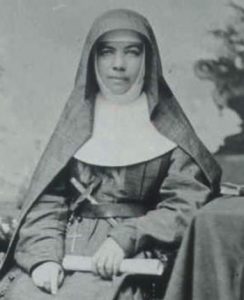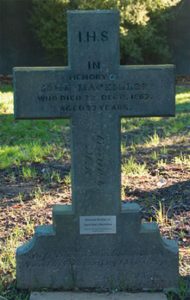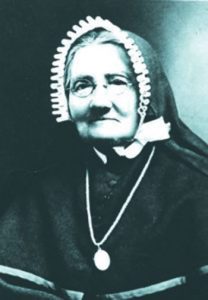Mary MacKillop and Suzanne Aubert
Part I
Who have been amongst the most notable Australasian women? For Catholics the response should be Suzanne Aubert, founder of the Daughters of Our Lady of Compassion and Mary MacKillop, St Mary of the Cross, founder of the Sisters of Saint Joseph. What is interesting about these two women is that their upbringings were remarkably different. Both found their ways to holiness. But what were their lives like before they ventured into their life changing vocations?
Family
Suzanne - Marie Henriette Suzanne Aubert was born on 19 June 1835 in St-Symphorien-de-Lay to Louis and Clarice, their second child. Suzanne had three brothers Alphonse, Louis and Camille. Louis was hydrocephalic and died when 12. Suzanne’s empathy for the chronically ill could have evolved from Louis’ health. Alphonse was educated by the Jesuit Fathers in Lyon. Camille, the youngest, was ordained priest .
Mary
Her parents came from Scotland. Alexander MacKillop, after several years studying for the priesthood in Rome and Scotland arrived in 1838 aged 26. Flora MacDonald arrived in Australia two years later aged 22, accompanied by her mother and brother Donald. Other family on both parents’ sides had emigrated previously.
Alexander and Flora were married shortly after. Mary was born in Melbourne on 15 January 1842, baptised as Maria Ellen. She was the first of 8 children. Margaret (Maggie) assisted Mary in the schools, she had a short life, 29 years. John was a carpenter, he died (1867) in Christchurch (where he is buried) from tetanus, a consequence of a fall from his horse. Alick died in infancy. Annie never married, she was the longest survivor living to about 80 - she led her own life and was very supportive of Mary in the schools prior to Adelaide then later when Mary was ill. Donald and Peter were educated by the Jesuits at Sevenhill in South Australia. Peter died when 21. Donald was ordained to the Jesuits and worked for several years in the Aboriginal missions before taking up pastoral duties in Adelaide then Melbourne. Alexandrina (Lexie) was involved in helping Mary and Annie with the first schools. She chose to join the Sisters of Good Shepherd in Melbourne. Described as a most loving and charismatic person, she passed away in December 1882, leaving only three surviving siblings from the eight, Mary, Annie and Donald.
Early years
Suzanne - Both Louis and Clarice Aubert brought family money and gifts to the marriage emphasing their bourgeois upbringings. Both families were committed Catholics and involved in the legal profession. Louis’ position was as a ‘huisser de justice’ (bailiff) where he progressed though the ranks especially after the family moved to Lyon when Suzanne was five.
Suzanne was two when she fell through ice on a pond and hit her head on rocks. As a result of this accident she was left crippled and lost her sight. Eventually she recovered. Once she described herself to an audience of doctors discussing eugenics - “As a child she had been un monstre, a freak”. Was this experience another factor in her Congregation’s concern for the handicapped?
Clarice was an enthusiastic Catholic where as Louis could be described as lukewarm, even anti-clerical, common with some men in France due to rivalry with the church partly over the role of women who had found outlets for their talents through church activities.
In 1840 Clarice became ill and steadily became worse until she was bed ridden. Suzanne was ten when Clarice insisted on being carried on her bed to mass at the Shrine of Our Lady of Fourviere during which she was cured sufficiently to be able to walk to the altar for communion. She had a full recovery. A miracle?
Before he died Louis embraced the faith and gave Suzanne in New Zealand his blessing and support.
Mary
Initially Alexander MacKilIop looked to have good prospects but later he was inadequate at supporting his family. Consequently the family suffered many hardships. When Mary was young they shifted homes several times as Alexander sought opportunities. Incredibly, he left his young family for over a year to accompany a friend on a trip to Scotland. The family had little to support them. He and John had an unsuccessful venture to New Zealand during the gold rush in Otago. Was Alexander a ‘rolling stone’? In his favour he encouraged the children with their religion.
Little is known about Flora other than that she had a strong faith. She relied on Mary for help with the children, for companionship and later to support the family financially. When Mary was away they communicated frequently. Flora was troubled about Mary’s wish to become a nun; she would miss her company and support. On Alexander’s death Mary wrote to Flora “I am sure you cannot regard Papa’s death as a trial”. Was Flora an unspoken saint?
Sadly Flora in 1886, on her way to visit Mary in Sydney, perished in a shipwreck off the coast of New South Wales.
Mary had a largely supportive family. Alexander’s parents and siblings had emigrated in 1839. Two brothers, Peter and John, became wealthy through farming. Alexander’s sister Margaret married Alexander Cameron, another wealthy man, to whom is attributed the founding of the township of Penola where Mary was to spend time that would be life changing for her. Mary’s grandfather, Donald MacDonald, was in Australia along with her grandmother; uncle Donald had arrived with Flora. Mary was especially fond of the MacDonalds.
Growing up
Suzanne - What do we know of Suzanne’s years before she left for New Zealand? She had rejected a planned marriage, telling her parents that when she was 25 she would join a religious congregation. This did not go down well with her parents, especially Louis.
About this time Lyon was the centre of Catholicism and Marianism in France. There was a huge growth in vocations. Institutions were set up by various groups to educate and to care for the less fortunate, of whom there were many following the revolution. The Society of Mary, Marists, was founded in Lyon in 1816. The Order expanded rapidly and was active in missionary countries including the Pacific. Suzanne had good rapport with them, which was to be important later when, in 1871, she went to the Marist community in Napier where she would meet up with priests she had known in France.
But what was happening in Lyon that would influence Suzanne? Many religious who had served in the missions returned to France with gripping tales of conversions and hardships, including Bishop Pompallier whose responsibilities were for New Zealand and the Western Pacific Islands. They were seeking persons to join their missions and finance to support their work. Suzanne would have been influenced by what she heard. And she had read letters from missionaries describing the challenges they were experiencing in the ‘wilderness’ of New Zealand and Pacifika. So she had some knowledge of what could lie ahead should she choose to follow them. What to do? Serve God by staying in the comfort of Lyon or take up the challenges in the southern hemisphere? Through Pompallier she could see there was a way to pursue her goal even if it meant leaving France. She must have thought and prayed about it before she made the crucial decision to leave.
Another factor - At that time Jean Vianney, Cure of Ars, was becoming well known as a spiritual advisor. Suzanne often visited him. Jean, canonized by Pius XI, was respected for his ability to see into a person’s soul and to offer counsel. People queued for hours to talk with him. The Cure made predictions about Suzanne some of which came about at later stages in her life. His influence was such that he is a patron saint of Suzanne’s Congregation.
What skills did Suzanne acquire in Lyon? She was intelligent and, as evidenced later, could master many practical tasks. She taught herself the rudiments of some science subjects. Her volunteer work had equipped her for basic nursing. All this was to be of value in her missionary work. She may have experimented with herbal remedies for which she became well known in New Zealand. Later, her Congregation’s concern for foundlings could have come from her experiences with abandoned infants in Lyon.
Mary
It was difficult for the family to have stability moving from place to place including a spell in Sydney, at times with little financial support. She mentioned her family life as ‘an unhappy one’. As well, the deaths of her siblings would have been upsetting. How well was Mary educated? Alexander was one source but of formal schooling little is known. Was the absence of significant opportunities for education a factor in her future? Her congregation are well known for their schools. Mary, when 14, took up paid employment as governess for the L’Estrange family. This was her first chance to support her family. Later she worked for a few years at the stationery firm of Sands and Kenny. The chance to pursue her wish to become a nun would arise when later she went to live in Penola.
Remarkably different upbringings that will lead to holiness.
Suzanne, from a middle class family, living in a vibrant Catholic city with many opportunities to increase her knowledge and experiences.
Mary from a family who struggled to make ends meet. Mary having to work to support the family and with few opportunities for education. Living in a country where the church was in its infancy.
Both ambitious to serve the church as religious.
References
The Story of Suzanne Aubert, Jessie Munro, Auckland University Press, 1998
An Extraordinary Australian Mary MacKillop, Paul Gardiner SJ, E.J.Dwyer (Australia) Pty Ltd, 1994
Acknowledgements
Sr Josephine Gorman, Archivist, DOLC, Island Bay, Wellington
Jessie Munro
The Congregation of St Joseph, North Sydney, requested the following -
Reasonable efforts have been made by the Sisters of St Joseph to verify the contents for accuracy and completeness. Please note that a review of content is not an endorsement by the Sisters of St Joseph.




 Entries(RSS)
Entries(RSS)